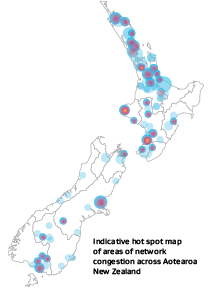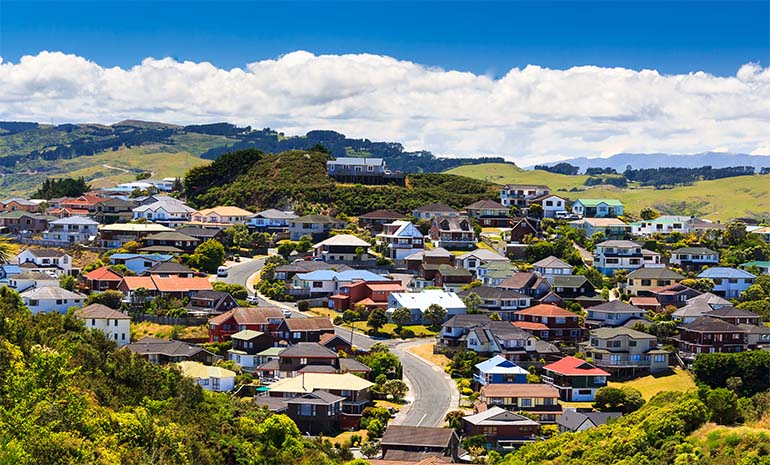Challenges and areas of focus
By the end of 2023, 87% of New Zealanders will have access to fibre at their home, and a total of 99.8% will have some form of improved access to broadband at the conclusion of current government connectivity initiatives.
On this page
In addition, mobile coverage is available in most places where New Zealanders work, live and study, and 5G is increasingly becoming available in regions across the country.
While these are achievements to be proud of, there is still a need to improve the quality of connectivity for many New Zealanders. There still remain large areas of New Zealand’s land mass where options for connectivity are limited, because of remoteness and very low population density such as over a large farm property or in a national park. In such cases, satellite coverage may be the only option for digital connectivity.
The importance of connectivity in our day-to-day lives means we need to keep focusing on improving broadband and mobile coverage, building on the success of the work done to date. Below we outline the challenges we will focus on in the years ahead to ensure New Zealanders have access to connectivity that meets their diverse needs.
Meeting the needs of people in rural and remote areas
Good connectivity in rural and remote areas is important for productivity and innovation, social connection and community building, health (including mental health) and safety, environmental compliance, and education. Good rural connectivity is also important for attracting and retaining skilled workers.
In addition, overseas customers and the countries New Zealand trades with are increasingly demanding that agricultural, horticultural and other primary produce be ethically sourced and environmentally friendly, including having low greenhouse gas emissions. Aotearoa New Zealand risks losing market access or customers if we fail to meet those demands.
Good connectivity enables the primary sector to make use of a wider range of technologies that assist with domestic and international market success. This includes demonstrating adherence to environmental regulations, meeting animal tracking and welfare requirements, and providing proof of provenance.

Focus areas:
There are still large areas in rural New Zealand without quality connectivity options. Remote households within these areas are going to be the hardest to reach, and a variety of technologies may need to be used to meet the needs of these households. As mentioned in the section: building on successful foundations, the Government’s Remote Users Scheme is a $15 million fund, which will provide bespoke connectivity solutions for remote and rural New Zealanders who have little or no connectivity at their principal residence. This scheme will help our hardest to reach households gain access to connectivity.
Improving network performance in our more populated rural areas

People in densely populated rural areas, including land surrounding our towns and cities, are experiencing increasing levels of network congestion. Network congestion occurs when the capacity of a network is insufficient to handle the total data transmission demand without degrading the performance to customers.
For wireless internet and mobile phone users, congestion can be a reduction in download and upload speeds or complete loss of service due to a lack of capacity available in that area.
It is estimated this issue could be affecting around five per cent of New Zealand’s population.
Typically, the affected areas do not have fibre to the premise, and the wireless coverage that may be available is being outpaced by data demands. This stems from increased demand on the network, for example, larger amounts of internet use per household or business, and additional users moving into the area.
Focus area:
In areas where wireless is still the most practical connectivity solution, we will need to determine how we sustainably manage network congestion issues in these areas so that rural communities can rely on a standard of network performance that meets their work, life and study needs.
Growth in urban-fringe areas
At the completion of the government’s UFB programme later this year, 87% of New Zealanders will be able to access UFB connections. This large UFB footprint means New Zealand has a high uptake of fibre by international standards, allowing the vast majority of New Zealanders access to connectivity that has the capacity to grow with increasing data demands.
The economics of rolling out fibre are directly tied to population density. The original footprint for UFB was set a number of years ago and population growth has occurred in and around our towns and cities since that time.
Focus area:
We need to consider whether technology such as fibre is viable in additional urban-fringe areas, taking into consideration the commercial incentives telecommunications companies already have to roll fibre out to these areas. Some local fibre companies are already rolling out fibre into these areas on a commercial basis.

Ensuring connectivity is reliable and is available in times of need
New Zealand’s telecommunications network infrastructure must cover a vast and varied geographic area. Events such as the Kaikōura earthquake of 2016, and recent flooding events, highlight that telecommunications networks can be vulnerable to a range of natural hazards (such as earthquakes, storms, volcanic activity, slips and erosion), human-induced hazards, and their effects. The impacts of climate change, such as increased high rainfall are also leading to more frequent floods in some parts of the country.
The resilience of New Zealand’s telecommunications networks is also dependent on the resilience of other infrastructure that carries it (e.g. bridges), along which it runs (e.g. roads or railway corridors) or upon which it depends for electricity.
Providing duplicate and back-up infrastructure is costly. This can leave rural areas more vulnerable as the greater distances involved, lower network density and smaller customer base means it is not viable to provide duplicate or alternative routes and connections.
Quick response and repair times and holding sufficient spare equipment or resources at remote locations are critical where there is no back-up. However, response times can be difficult to meet if the infrastructure affected is remote from the resources required for restoration.
Focus area:
The standard and location of Aotearoa New Zealand’s connectivity infrastructure, and the approach to protecting and restoring services, must consider the direct and indirect impacts of the risks being managed. The approach to managing risks should complement approaches and measures for managing Aotearoa New Zealand’s other critical infrastructure.
Consumer awareness of connectivity options available
Government regulation of the telecommunications sector focuses on supporting healthy competition. Competition is also supported when consumers are able to make informed choices about the connectivity products that meet their needs.
Broadband Map NZ (broadbandmap.nz/home) is an independent source of information about the availability of broadband in New Zealand, administered by Internet NZ. New Zealanders can use it to check their broadband options before buying, renting or building a property, for finding a different provider in their area, and for learning more about the roll-out of government connectivity programmes, such as when coverage is being extended to particular areas.
The Commerce Commission also has an important role to play in monitoring the telecommunications market and providing information to New Zealanders to support consumer choice. Measuring Broadband New Zealand (measuringbroadbandnewzealand.com) is a project run by the Commerce Commission. It provides consumers with independent information on broadband performance across different technologies, providers and plans.
Focus area:
Supporting informed consumer choice of connectivity products enhances competition and a well-functioning telecommunications market. Government will continue to focus on measures to support consumers in making informed choices about connectivity products and services.

